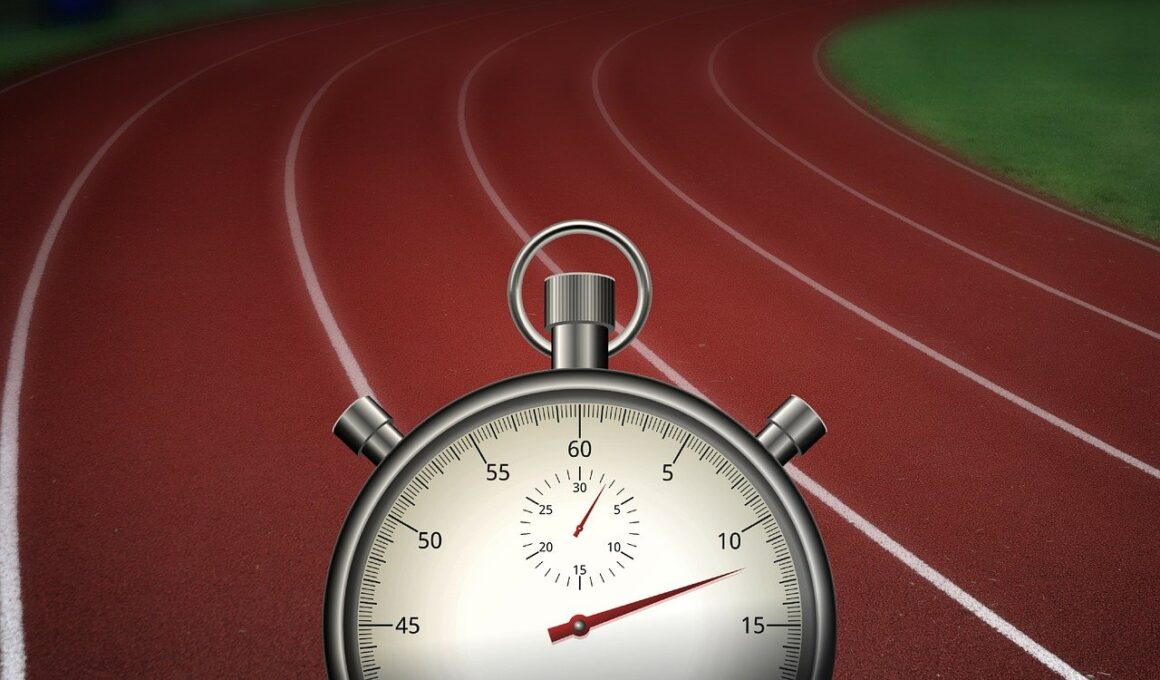How to Pace Yourself in a 5K Race
Pacing yourself during a 5K race is crucial for maximizing performance and enjoyment. Understanding your own fitness level is the first step in determining a sustainable pace. Before the race, it’s important to do some practice runs at different speeds. This will help you identify a target pace that feels comfortable and achievable. Taking into consideration environmental factors like weather conditions and the terrain can also impact your pace strategy. For instance, a flat course may allow for a faster speed compared to a hilly one. In addition, integrating interval training into your routine can significantly enhance your pacing skills. This involves alternating between high-intensity efforts and recovery periods. Be sure to listen to your body and adjust your strategy as needed during the race. Don’t forget to hydrate and fuel adequately before and during your runs. Properly managing these factors can prevent fatigue and help maintain your energy levels throughout the race. A well-planned strategy will not only lead to better finishing times but will also contribute to an overall positive racing experience.
Establishing a pre-race routine can significantly aid in your pacing strategy. This routine might include a thorough warm-up that prepares your muscles for the demands of the race. Start with dynamic stretches to increase blood flow, followed by light jogs. Additionally, consider practicing your pacing during training runs, replicating race conditions as closely as possible. By completing a time trial a few weeks before the race, you can determine the best pace for you. Establishing a goal time also helps set attainable pacing targets. On race day, ensure you arrive early to settle your nerves. Familiarize yourself with the racecourse and gather insights on potential challenges. Getting a visual understanding of the layout allows you to mentally prepare for turns, hills, and straightaways. When lining up to start, position yourself among runners at a similar pace. This can reduce the temptation to start too fast. Pay attention to your watch throughout the race, especially during the first mile. Many runners make the mistake of starting too quickly and burning out, so a gradual approach is essential. Practice discipline and stick to your predetermined pace to ensure a successful race.
Understanding the 5K Course
Each 5K race presents unique challenges and advantages based on its course. Familiarizing yourself with the specific characteristics of the racecourse can be beneficial for your pacing strategy. Courses can vary in elevation, surface, and environmental elements, impacting your overall performance. If your race is predominantly flat, you might feel motivated to push your pace early on. However, hilly terrains demand a more conservative approach. Consider how the inclines may affect your energy and adjust your pacing accordingly. Knowing where the turns and water stations are can enable you to plan your race strategy effectively. Additionally, be aware of the weather conditions. On hot days, it’s wise to slow down to prevent overheating and dehydration. Conversely, cooler temperatures might allow for faster speeds but should still be managed carefully. Ensure you don’t overlook safety aspects, especially on crowded courses. Watch out for bottlenecks or uneven surfaces that may require you to adjust your stride. A tailored approach based on the course will enhance your chances of achieving a personal record or simply enjoying the race.
Another key element to refine is your mental approach to pacing. Visualization techniques can enhance your focus and performance. Take time before the race to visualize yourself running smoothly, maintaining a consistent pace. Picture successfully navigating through challenging portions of the course. Furthermore, during the race, use positive affirmations to maintain motivation. Reminding yourself of your training and preparation can boost your confidence. Breaking the race into manageable segments, such as each kilometer or mile, can also aid in maintaining motivation. Celebrate small milestones as you progress. Instead of viewing the entire 5K as one continuous struggle, treat each segment as an achievement. As your body fatigues, it’s essential to remain mentally strong and focused on your pacing strategy. If you feel fatigue setting in, remind yourself of the end goal and encourage yourself to stick to your pace. Engaging with spectators can also provide a much-needed boost, so don’t hesitate to embrace the support. Ultimately, your mental game can be just as significant as your physical training when it comes to pacing in a 5K race.
Race Day Preparations
On race day, your morning routine plays a vital role in your pacing success. Start with a balanced breakfast that’s rich in carbohydrates and low in fats. Foods like oatmeal, bananas, or toast with honey can provide lasting energy. Hydration is equally critical; ensure you drink enough water before starting but avoid excessive consumption to prevent discomfort. Arriving at the event allows ample time to warm up and build momentum. Light jogging and dynamic stretches will elevate your heart rate and prepare your muscles. Take moments for mental preparation to establish focus and reduce anxieties. Establishing your race strategy beforehand allows that you have fewer decisions to make on the go. Stick to your planned pacing and energy consumption for a smoother race experience. During the race itself, begin at a slower pace than your goal to avoid early fatigue. Monitor your heart rate throughout to manage exertion levels. Keeping your breath steady will also help sustain your performance. Finally, remember to enjoy the experience! Embrace the thrill in crossing the finish line and reflect on your accomplishments afterward.
Post-race evaluation is vital for improving future pacing strategies. Take notes on how you approached your race and what worked or didn’t work. Review your pacing plan, paying attention to when you felt strong or fatigued. This reflection can reveal valuable insights into your physical limits and pacing effectiveness. Depending on how your 5K went, consider adjusting your training plan. If you experienced difficulties maintaining your intended pace, analyze factors like nutrition, hydration, or mental focus during the race. You might decide to engage in more speed work during training or alter your nutrition strategies. Sharing your experience with fellow runners can also offer new perspectives. Look for online forums or running groups where you can exchange stories and strategies. Constructive feedback from peers might introduce unfamiliar techniques to enhance your pacing. Engaging in this reflective practice will not only aid in your development as a runner but will also inject freshness into your training routine. Every race provides an opportunity to learn, and each lesson can help sharpen your pace strategies for upcoming 5Ks.
Conclusion: Mastering Your Pacing
In conclusion, mastering your pacing strategy for a 5K race is a blend of mental and physical preparation. Understanding your unique condition, followed by tailored practices, will lead to more rewarding running experiences. Engage in trials, assess various courses, and work on mental strength alongside physical training. Prioritize consistent training and practice the many strategies identified throughout the article. Adjust according to individual environments and conditions to amplify your performance. A successful pacing strategy hinges on discipline; resist the urge to sprint out of the starting gate. Instead, implemented gradual speed increases will allow for clearer energy management. During the race, integrate the insights gathered from reflection and visualization techniques to maximize your potential. The camaraderie within the running community is an extra motivation, transforming races into exciting events, so do not shy away from enthusiasm. Commit to evaluating your runs and sharing insights with others, perpetuating a cycle of improvement. Before long, you will see how structured pacing vastly contributes to successful and enjoyable race experiences. Embrace the journey, and celebrate the milestones along the way as you continue improving your pacing strategies.
By incorporating these elements into your pacing strategies, you’re setting yourself up for success in future races. Make the most of each opportunity to refine your techniques and build your confidence as a runner. Enjoy the process and watch your improvements unfold.


